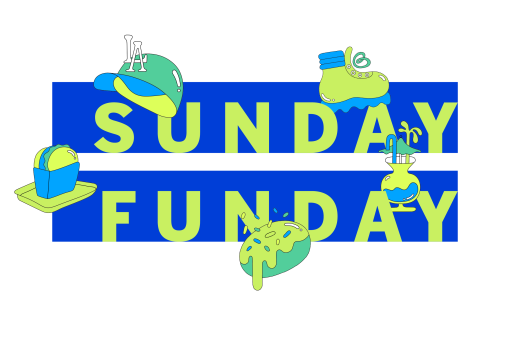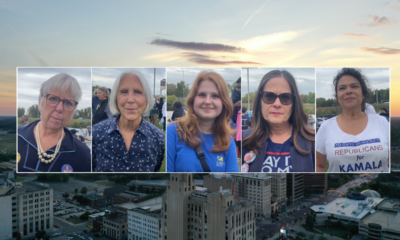Lifestyle
College credit for working your job? Walmart and McDonald’s are trying it

Bonnie Boop is now a people lead at Walmart in Huntsville, Ala. She received college credit for a company training program, graduating with a bachelor’s degree last year.
Andi Rice for NPR/Andi Rice for NPR
hide caption
toggle caption
Andi Rice for NPR/Andi Rice for NPR
When Walmart stopped requiring college degrees for most of its corporate jobs last year, the company confronted three deep truths about work and schooling:
A college diploma is only a proxy for what someone knows, and not always a perfect one. A degree’s high cost sidelines many people. For industries dominated by workers without degrees, cultivating future talent demands a different playbook.
Some of the nation’s largest employers, including Walmart and McDonald’s, are now broaching a new frontier in higher education: convincing colleges to give retail and fast-food workers credit for what they learn on the job, counting toward a degree.
Behind the scenes, executives often paint a grander transformation of hiring, a world where your resume will rely less on titles or diplomas and act more like a passport of skills you’ve proven you have.
For now, companies and educators are only starting to chip away at one of the first steps: figuring out how much college credit a work skill is worth.
Getting credit for Walmart training
Something unusual happened to Bonnie Boop one semester.
She’d returned to college in her late 40s using Walmart’s tuition-assistance program after joining the company as a part-time stocker. In her younger years, she had gotten two associate degrees, so her children used to joke that she might as well say she’d gone to school for four years. But to her, it wasn’t the same.
“Bachelor’s degrees tend to open more doors,” Boop says. Plus, she says, she persisted for “the principle of it all.”
At Walmart, Boop stocked health and beauty aisles in the evenings after another day job. Later, she went full time and got promoted to supervise others. This required new training at “Walmart Academy”: brief, intensive courses on leadership, financial decision-making and workforce planning.

Walmart and a few other companies are working with colleges to figure out how to convert skills — or at least trainings — done at work into college credit.
Andi Rice/for NPR
hide caption
toggle caption
Andi Rice/for NPR
Then one day, looking at Boop’s upcoming business-operations class at Southern New Hampshire University, which Boop attended online from Alabama, her adviser found the record showing she’d already taken the course.
“But I didn’t,” Boop says. “And she said, ‘Yes, you got credit from Walmart Academy.’ And I said, what?”
Through corporate training and certificates that convert to college credit, Walmart Academy aims to get workers as far as halfway to a college degree, the organization’s chief told NPR. Boop had done several such programs, which let her bypass two college courses.
At her rate of study, “that would have been two semesters’ worth,” Boop says. “I was like, wow!”

Studying while also holding down a job meant staying up late after her shift that ended at 11 p.m. and keeping a meticulous schedule of big school projects to do on her days off. After 2 1/2 years of this, expedited by her associate degrees, Boop watched her photo slide across the screen at the virtual graduation in December.
Wearing her cap and gown, she posed for photos with her new diploma: Bachelor of Science in business administration, with a concentration in industrial organizational psychology. Today, Boop is her store’s “people lead” overseeing more than 200 workers.
What’s in it for corporations?
Many American universities have long offered credit for corporate training by companies like Google, IBM or Microsoft. For work in retail and fast food, the process is nascent.
McDonald’s is working with several community colleges to build a path for converting on-the-job skills, like safe food handling or customer service, into credit toward degrees in culinary arts, hospitality or insurance. Walmart has over a dozen short-form certificates and 25 training courses — in tech, leadership, digital operations — that translate to credit at partner universities. The car-service chain Jiffy Lube has its own college credit program, too.
“For adults who feel like they weren’t college material, what we are able to do is say, ‘You are. And you’re doing college-level work already,’” says Amber Garrison Duncan, who runs the nonprofit Competency-Based Education Network that connects employers and higher-education institutions.
Educators hope this brings more students into the fold — expanding access to education and allowing more people to achieve better-paying, more-secure careers with less debt and fewer years of juggling work and study.
For companies that offer tuition assistance to employees, the idea that work skills should count toward college credit makes financial sense: It means a student spends less time in school and doesn’t have to pay for classes that would teach them something they already know.
And paying for tuition can attract workers in a competitive labor market and keep them longer, slowing turnover, saving money on recruitment and training, and cultivating more loyalty to the employer.

Bonnie Boop became her store’s people lead within weeks of completing her courses for the Bachelor of Science in business administration, with a concentration in industrial organizational psychology.
Andi Rice/for NPR
hide caption
toggle caption
Andi Rice/for NPR
McDonald’s and Amazon executives say this is exactly their motivation, noting that many people use their jobs as stepping stones to elsewhere. Walmart’s executives differ, saying that their goal is to build a pipeline of talent from the front lines to open positions within the company.
The U.S. military paved the way, but it’s not the same
Counting existing knowledge toward a degree is not a radical idea. Plenty of high school students get a head start on college with credit for AP, or “advanced placement,” classes. Many colleges also offer “credit for prior learning” that lets students skip foreign-language classes if they’re already fluent — or test out of courses through special exams or assessments.
The U.S. military took the idea further in recent decades. It worked with the American Council on Education to build a comprehensive database of how its jobs and training programs translate to college credit.
“There’s no rule about what colleges and universities have to accept,” says ACE’s Derrick Anderson. “But they can look at the person’s military record … and they figure out how much credit they want to award.”
This and other education support made the military “a powerful engine of socioeconomic mobility,” Anderson says. His group’s database of recommended credit now spans work experience beyond the military: government, nonprofits, apprenticeships.
“What I see working with employers, higher education and workforce organizations is a growing understanding that work and learning have been two silos in the past and can’t be two silos in the future,” says Haley Glover, director of Aspen Institute’s UpSkill America initiative.
What about skills simply gained by working?
For now, most of the college credit for work experience focuses on “prior learning” that’s taught in a classroom — standardized, structured and measurable enough to fit rigid criteria — such as training or certification programs.
Figuring out how to map on-the-job skills gained otherwise is the big leap.
“It’s a complex thing,” Glover says. “It requires an employer to be very rigorous about how they’re codifying and assessing, and that’s a capacity that a lot of employers don’t have. It also requires institutions of learning to be very open and progressive.”

Bonnie Boop started at Walmart as a part-time stocking associate and returned to college using the company’s tuition-assistance program.
Andi Rice/for NPR
hide caption
toggle caption
Andi Rice/for NPR
Historically, some colleges have allowed students to present a portfolio, diligently documenting learnings on and off the job.
The McDonald’s pilot program is considering how this could work for restaurant employees. Some schools offer a separate course, for example, specifically for compiling a work-skills portfolio.
But expanding this system to the retail and food-service universe would require an army of academics willing to perform individual reviews. That’s a tremendous amount of time, and professors are often hesitant to commit — especially if it means they’d miss out on a potential student.
“This definitely is a process that disrupts what traditional higher ed is used to, in terms of seat time — credit for sitting in a class and doing assignments,” says Brianne McDonough at the workforce development nonprofit Jobs for the Future. “It’s a big change.”
Then, there are more basic challenges. Many workers simply don’t know about their employers’ education offers or struggle to navigate the application bureaucracies. They often receive little scheduling leeway to balance their working and studying hours.
“Shockingly tragic” was how Anderson described the small share of workers taking advantage of corporate college perks.
That’s partly why hiring and education officials talk about a “skills-first approach” to higher education — a future of short-form certificates and credentials weighed on par with college degrees.
“This is a problem that a lot of companies are trying to solve for,” says Lorraine Stomski, who heads Walmart’s learning and leadership programs. “What are the rules of the future?”

Lifestyle
A beloved music producer is dying. His clients came to his home for a farewell concert

Classical music producer Adam Abeshouse was diagnosed with bile duct cancer last spring. His clients — including Simone Dinnerstein, Jeremy Denk and Joshua Bell — performed a concert in his home studio to bid farewell. “I was just thinking of how many of us wanted to celebrate Adam while he’s still here,” said pianist Lara Downes, who organized the event.
Rick Marino/Abeshouse Productions
hide caption
toggle caption
Rick Marino/Abeshouse Productions
On a recent Friday afternoon, Adam Abeshouse, one of the world’s leading producers of classical music, lay on his bed in his Westchester, N.Y., home, propped up with pillows, waiting for his pain medicine to kick in. He struggled to talk about his life’s work with a star-studded list of clients, which includes celebrity violinist Joshua Bell and pianist Garrick Ohlsson.
“I worked very hard for my clients,” the 63-year-old producer said. His breathing was labored. “I was devoted to them. From the devotion to the clients, I developed this theory that the best thing that I could do for my clients is make them feel safe, and loved, and create an atmosphere in the recording session to do their best.”
Last spring, Abeshouse was diagnosed with bile duct cancer. It progressed with devastating speed. In August, his doctors told Abeshouse he had only weeks to live. One of his clients, pianist Lara Downes, organized an at-home concert by the musicians he’d worked so closely with for decades.
Downes, who also hosts a video conversation series with NPR and Classical California, said the musicians wanted to give their beloved producer a chance to share music together one final time.
“Somehow, it worked out that we could all get here today to be together,” Downes told NPR. “I feel like it was sort of meant to be. This is Adam’s family and it’s such a gift that we can do this.”
The concert took place in the producer’s state-of-the-art studio, adjacent to his home. Abeshouse, wearing khakis and a bright blue polo shirt, sat listening in a wheelchair a few feet from the performers, flanked by friends and family. He held hands with Maria Abeshouse, his wife of 38 years.
The program opened with solo pieces played by acclaimed pianists Simone Dinnerstein and MacArthur “genius” grant winner Jeremy Denk on a Steinway grand that was built in 1906. Then a Grammy-winning string trio called Time for Three performed an original composition. Next up was pianist Garrick Ohlsson, widely regarded as a leading interpreter of Frédéric Chopin, playing the composer’s Nocturne in C Sharp Minor.

Adam Abeshouse’s clients joined him at the studio adjacent to his home for a farewell concert. Joshua Bell, first row, from left, Adam Abeshouse, Larisa Martinez and Kevin Puts. And, second row, from left, John-Henry Crawford, Charles Yang, Peter Dugan, Lara Downes, Ranaan Meyer, Garrick Ohlsson, Jeremy Denk, Nicolas Kendall and Simone Dinnerstein.
hide caption
toggle caption
“He was the first producer I ever worked with who made recording — a pleasure is the wrong word — but a plausible joy,” Ohlsson said after his performance. “He is the most sympathetic human. He’s got the best ears. He’s got the best musical instincts and technological wizardries. And I’ve done maybe 30 CDs with him over the years. And he’s a dear friend and one of the greatest people I’ve ever known.”
Celebrity violinist Joshua Bell brought his rare Stradivarius, crafted in 1713, to play for Abeshouse. He’d flown in from Europe the night before.
“Adam has been both a dear, dear friend and he’s been my producer for the last 20 years,” said Bell. “I’ve spent many hours with him in the studios, sitting next to him, doing a process which is usually excruciating for me — the editing process. But with him, it always became a fun time together. Those moments have been so precious to me.”
Bell accompanied his wife, soprano Larisa Martinez, on a Mendelssohn aria.
Bell noted that Abeshouse is also a classically trained violinist. “And he understands music from a violinist’s perspective,” he said. “We just get along so well. He’s become my hero on top of everything, just the way he’s been dealing with his setbacks with such dignity. He’s just one of those people who everybody loves. You never hear an unkind word about Adam Abeshouse.”
Over the course of the concert, nearly a dozen musicians played for Adam Abeshouse. Each one embraced him after performing. At least for one afternoon, joy supplanted pain.
“This is more than I could have ever dreamed,” Abeshouse said. “All these musicians are coming to play for me. It’s kind of a miracle.”
A musical miracle to bid a classical luminary godspeed.
Edited by Neda Ulaby. Produced for the web by Beth Novey. Produced for the radio by Chloee Weiner.


Lifestyle
How to have the best Sunday in L.A., according to Charlie Puth

When pop singer-songwriter Charlie Puth first began visiting Los Angeles in the early 2010s, he remembers landing at a house near Mount Olympus with an incredible view. Though he‘d only recently become a legal adult, he’d already built a following as a YouTuber, posting covers and singing intro songs for popular creators on the platform. That day in Laurel Canyon, he looked out over the sprawling metropolis.
“And in a very like ‘Entourage’ way, I was like, I will live here one day, and I will make it in the city,” he said.

In Sunday Funday, L.A. people give us a play-by-play of their ideal Sunday around town. Find ideas and inspiration on where to go, what to eat and how to enjoy life on the weekends.
Fast-forward to today, the Grammy-nominated hitmaker has charted 13 Billboard Hot 100 songs, worked with everyone from Elton John to Selena Gomez and is considered underrated by the most famous pop star in the world. As of this week, he also has his own heavily-improvised six-episode Roku Original comedy series, “The Charlie Puth Show,” where the New Jersey-native parodies the absurdity of the entertainment industry.
“We poke fun at that the egregious, unapologetic agents saying, ‘You’ve sold millions of records, but it’s time to do a reality show,’ ” he said.
And up until a recent move to Santa Barbara, Puth fulfilled his dream of living in Los Angeles, where he still often spends Sundays chasing caloric Valhalla and doing “the opposite” of his job so he “can remain sane.” Below, the “Hero” singer shares his ideal Sunday in Los Angeles.
This interview has been lightly edited and condensed for length and clarity.

7 a.m.: Rise and sweat
I’m waking up. I walk down either Carla Ridge or run up Loma Vista, up in Trousedale [Estates], and get exhausted. That’s about an hour. Just get a good sweat.
8 a.m.: One shake, two shake
I immediately cancel out that wonderful workout with a big breakfast burrito from Dialog [Cafe] and a date shake. But I’m not going to Dialog. I’m Postmating it and tipping my driver well.
I’m very hungry. I’ve just run up a huge mountain, so I’m eating that and simultaneously ordering the Paul Saladino raw shake from Erewhon. The meat one. I love that shake. And I always get a bone broth from Erewhon, too. So the day hasn’t even started, and I’ve spent an absurd amount of money on ordered food. I’m living in La La Land.
9 a.m.: Pool hang
I take a shower, and if it’s nice out, I’m fortunate enough to have a pool, and jump in that. Maybe see what a couple friends are doing.

10:30 a.m.: Group brain rot
I love having company over. I’ll call my friend Adam, I’ll call my friend Jeff, who works at my record label, and we will just watch brain-rot TikToks.
You don’t want to know stuff that I show my wife. Brooke [Sansone]’s, like: ‘I don’t even know what kind of response I can garner up for this.’ I’m looking at a meatball — and it has two eyeballs on it, like Stick Stickly from Nickelodeon. And it says “Meatball Martin is calling you.” And there’s a sound of like an iPhone ringing. And that’s the TikTok. My friends and I just die laughing. [We can spend] easily, nine hours [doing that]. We’ll start to get headaches from being on our phones too much.
I hope you weren’t thinking that, ‘Oh, I go up Runyon Canyon or Fryman Canyon, where I go to the Getty. I go to Zuma Beach. I go to the Greystone Mansion or I go down to South Central and get some really great homemade brisket. Or we go to Woon on the East side, Silver Lake and then at night, dancing.’ I know all those amazing places exist. I go to all those places during the week. It’s just Sunday, and so I just want to be home.

12 p.m.: Get him to the Greek
It’s Sunday, so we’re ordering Matū cheesesteaks in Beverly Hills. Right on the dot at noon. It’s a delicious option for lunch. And if we’re feeling adventurous, we will take the car and go down to Go Greek on Bedford [Drive] and just get an after-cheesesteak yogurt. It’s an upscale frozen Greek yogurt place. It’s a local place and it is really good.
[Building a yogurt cup] starts healthy, but then come the gummy worms and the chocolate chips.

3 p.m.: Mall crawl
I’ll put on a little hat, some sunglasses and we’ll run to the Westfield Mall down in Century City. We’re moving slow, a lot of food’s in us.
It’s the best mall ever. We don’t even buy anything. We just walk around. Walking is such a reward after going through that insane parking garage to get into that mall. I just like to be among the people and not get noticed and not have it be a big deal. It kind of grounds me.
We’ll probably stay there for like 45 minutes and then take the car to Silver Lake, where the real eats are at.

5:00 p.m.: The feast continues
We go to Burgers Never Say Die. They have soft serve too. I’ll get chocolate vanilla swirl with a side of four burgers and cheese sauce. They have really good cheese sauce there. I don’t know how they do it. Actually, yes, I do. I know how they do it. They fry their french fries in beef tallow, which is what McDonald’s used to do, and that’s why they taste so crispy and nice.
That’s when I take my hat off, because we’re in Silver Lake, and you see everybody doing the same thing as me and my buddies. So we’ll just eat that on the hood of the car.

7:00 p.m.: Artisanal Diet Coke and a movie
Then we’ll, you know, we’re in L.A., so we’re driving a lot. And if it’s not too traffick-y, which it shouldn’t be, we’ll hit the 405 and get off at the Palisades. And there’s actually a movie theater in the Palisades Village. The last thing I saw there was “Tick, Tick… Boom!” with Andrew Garfield. [Sings “Come to Your Senses”]
They have really, really good Diet Coke there. It just remains crispy. It’s way different than having it out of the can, fresher than the bottle. It’s mixed within the machine. And it just remains spicy. I drink Diet Cokes by the sleeve. It’s like, I’m a Pez dispenser of Diet Coke.
9 p.m.: Evening snack
Since we’re on the West side, we might as well. If we’re still hungry, we’ll go to Eduardo’s [Border Grill], which is a really, really wonderful burrito spot.
9:45 p.m.: Fourth dessert
Then we’re ending the evening with more ice cream. We’re going to the Bigg Chill in Westwood. I love Los Angeles. Living in Los Angeles changed my life. It also changed my weight.
Anybody reading this, you can eat whatever you want in Los Angeles, you can go to Matsuhisa. You can do your Nobu. You can do anything you want, as long as you run up Loma Vista. That’s how you burn the cals.

10 p.m.: Demo tape drive
After that, we are driving around looking at all the nice houses in either Hancock Park or on Beverly in Beverly Hills, just listening to demos. A lot of my friends are in the music industry, so we’re just listening to what songs are coming out, what songs they’re working on, what songs I’m working on. All my records are basically mixed in the car, even if the sound system is a little wonky, I still want to hear it on a car stereo sound system, because that’s how people are going to listen to the music.
That’s the great thing about L.A., is that you can just remain inspired, because there’s creatives all around.
I don’t know a ton about Hancock Park, but I do admire how the streets are kind of an S-shape curve. And I did research on it one day. Why are the streets like that? [It’s] so people don’t drive quickly. That’s how it was designed a really long time ago. They could have easily made the road straight, but it’s more dramatic for the road to be an S-shaped curve, I guess.

11 p.m.: ‘Toks and Sopranos
Anticipating that Monday is going to be a pretty busy day, I try get back home at like 11 to shine the night off with some last-minute brain rot ’Toks. And say goodbye to my friends and watch “Sopranos” with my wife. I think James Gandolfini is one of the best actors of our time. May he rest in peace.
It’s a series that I can watch over and over and over again, because it’s based on where I’m from, New Jersey, so I feel some sort of affection towards it. It’s just seeing the intro of Elizabeth, N.J., which is what you see when you land at Newark Airport and all the factories. There’s something that is just very reminiscent of home, even though I didn’t live at the factory.
12 a.m.: Bedtime
I do my best to just not look at the phone, but it never works. I’m sure I get 30% less great sleep. But that’s a wonderful Sunday to me. Sunday full of relaxation.
Lifestyle
Sunday Puzzle: Phonetic fun!

Sunday Puzzle
NPR
hide caption
toggle caption
NPR
On-air challenge: This is a phonetic puzzle. If I asked you to say a letter of the alphabet before one of the gifts of the Three Wise Men to get a boy’s name, you’d put L before MYRRH to get ELMER. Now try these.
Say a letter of the alphabet before … to get …
- … a decoration on a gift … a thin musical instrument
- … a carpenter’s tool … a biblical patriarch
- … a boundary of a field … a word meaning “prevention of a team from scoring”
- … the sound a cat makes … part of a car that clears a windshield
- … the opposite of war … a monocle, for example
- … where a judge presides … a person who accompanies someone on a date
- … a son of Adam and Eve … a word meaning “difficult to understand”
- … a mean, mixed-breed dog … a card game
- … a word meaning “having a raspy voice” … a fish that swims upright
- … a seabird with a harsh call … a dog with floppy ears
Last week’s challenge: Last week’s challenge came from listener Curtis Guy, of Buffalo, N.Y. Name a certain breakfast cereal character. Remove the third, fifth, and sixth letters and read the result backward. You’ll get a word that describes this breakfast cereal character. What is it?
Challenge answer: Toucan Sam, Mascot
Winner: John Weaver of Tacoma, WA.
This week’s challenge: This week’s challenge comes from listener Joe Krozel, of Creve Coeur, MO. Think of a place in America. Two words, 10 letters altogether. The first five letters read the same forward and backward. The last five letters spell something found in the body. What place is this?
Submit Your Answer
If you know the answer to the challenge, submit it here by Thursday, October 10th, 2024 at 3 p.m. ET. Listeners whose answers are selected win a chance to play the on-air puzzle. Important: include a phone number where we can reach you.
-
/cdn.vox-cdn.com/uploads/chorus_asset/file/25439572/VRG_TEC_Textless.jpg)
/cdn.vox-cdn.com/uploads/chorus_asset/file/25439572/VRG_TEC_Textless.jpg) Technology4 days ago
Technology4 days agoCharter will offer Peacock for free with some cable subscriptions next year
-

 World4 days ago
World4 days agoUkrainian stronghold Vuhledar falls to Russian offensive after two years of bombardment
-

 World4 days ago
World4 days agoWikiLeaks’ Julian Assange says he pleaded ‘guilty to journalism’ in order to be freed
-

 Technology3 days ago
Technology3 days agoBeware of fraudsters posing as government officials trying to steal your cash
-

 Health2 days ago
Health2 days agoHealth, happiness and helping others are vital parts of free and responsible society, Founding Fathers taught
-

 Virginia5 days ago
Virginia5 days agoStatus for Daniels and Green still uncertain for this week against Virginia Tech; Reuben done for season
-

 Sports2 days ago
Sports2 days agoFreddie Freeman says his ankle sprain is worst injury he's ever tried to play through
-

 News2 days ago
News2 days agoLebanon says 50 medics killed in past three days as Israel extends its bombardment
















